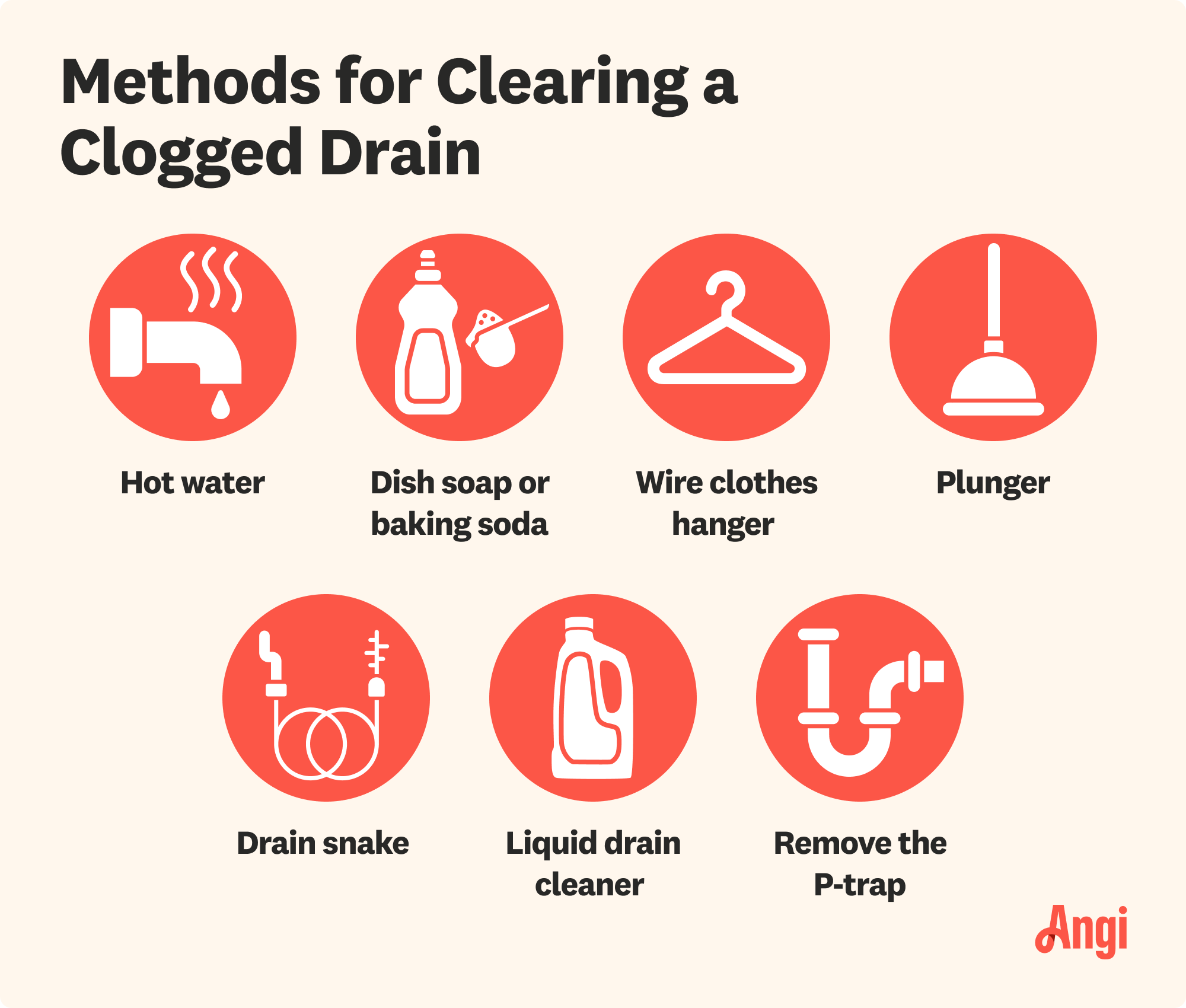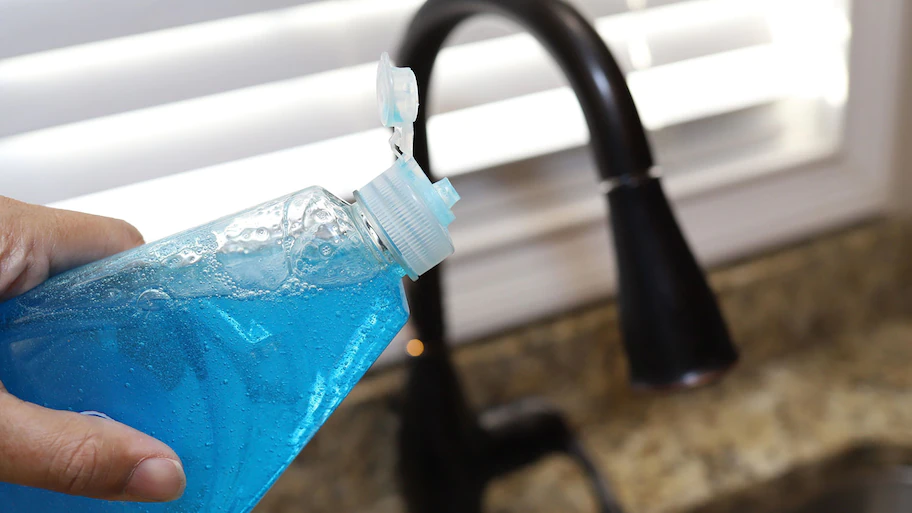
Worried about water leaking around your toilet? You may have a faulty toilet flange. Learn more about the cost to replace a toilet flange in our guide.
Plunge into DIY clog removal


The cost to clear a drain professionally is around $250, but hiring a professional may be worth it if you have a clogged sewer line or blocked plumbing vents.
You could damage the drainpipes while attempting to remove a clog, leading to more costly repairs.
Using a liquid drain cleaner as a DIY fix might provide temporary relief, but a sink repair pro will offer a longer-lasting solution.
Sink and tub drains are rarely at the forefront of our thoughts until they stop working. Most of the time, these systems work flawlessly, and they don’t require much attention. However, when drains become clogged with hair, fats, soap scum, oils, starch, or foreign objects—not only does it keep water from draining—but it can plug up your day as well.
Fortunately, not every stopped drain means you’ll have to shell out big bucks to cover the cost of drain cleaning. You can sometimes implement a simple DIY solution to clear a drain using a few things you may already have around the house. Here are some time- and money-saving tips for how to clear a clogged drain yourself before calling a plumber.
So you have a clogged drain that’s moving slowly, but water is still moving down the pipes. Why should you worry about clearing it? Besides the noticeable difference in draining speed—which is an annoyance in itself—there are a few other problems that a clogged drain can cause. Some of the reasons that you should clear a clogged drain include:
Preventing water damage: A drain that isn’t draining properly can cause water to back up or overflow. If you’re not around to do something about it, this can lead to water damage to counters, floors, or walls. Water damage can also lead to mold growth, which can be costly to remove.
Preventing plumbing problems: Water that isn’t draining can cause damage to your drainpipes, especially if you resort to using caustic drain cleaners to try to solve the issue., Ultimately, this could lead to corrosion and leaks. The cost of fixing a bathroom leak can vary, but it could be expensive depending on where the leak is.
Preventing bad odors: A clogged drain will cause a smell due to the dirty water sitting in your drain. As expected, this smell won’t be the most pleasant, and eventually, the smell will move from the clog in the sink to the rest of the room. Keeping a smelly drain clean will help keep the odor away.
Clearing a clogged drain as quickly as possible can help prevent unnecessary, costly expenses. Luckily, clearing up a minor clog in a drain is often something you can do yourself with little time and up-front cost.

Sink and tub drains look different because a tub drain usually has most of its parts hidden under or behind the tub, while a sink drain is often exposed. However, both work in the same way, and you can use mostly the same techniques and tools to unclog either type.

If your drain is clearing slowly and there’s no standing water left in it, hot water is sometimes enough to dissolve a drain clog caused by solidified fat, oil, or other waste.
Bring approximately 1/2 gallon of water to a boil.
Slowly pour the water directly into the drain.
Flush the drain with hot tap water for five minutes, but stand by to check for overfilling.
Note: Don’t ever pour boiling water down the drain if you have PVC pipes as it can lead to melting. If you have PVC drainpipes or are unsure if you do, use hot water around 180 degrees Fahrenheit instead of boiling water.

Sometimes, dish soap can break down a greasy clog and get things moving again, and it can even lubricate other clogged material and help it along, including hair. However, don’t go overboard, as too much soap can lead to suds. If the soap fails to go down the drain, it can solidify and leave behind soap scum, potentially leading to a greater clog.
Squirt 1 ounce of dish soap directly into the affected drain.
Slowly pour hot water around 180 degrees directly into the drain.
Flush the drain with hot tap water for several minutes, but be ready to shut the water if the clog persists.

A homemade drain cleaning solution you can try is baking soda with lemon juice and water or vinegar.
Mix 1 cup of baking soda with 3 cups of boiling water and 1 cup of lemon juice.
Slowly pour the mix into the slow drain.
Pour 1/2 cup of baking soda directly into the drain.
Immediately pour 1/2 cup of white vinegar into the same drain.
Pour several cups of hot water into it.
Let it sit undisturbed. It may take up to an hour to see results.

If the drain still runs slowly after trying to clean it out using gentle methods, you can try to go after the clog with tools.
Plastic drain cleaning tools are 24-inch to 36-inch long strips that have barbs cut into them. They’re inexpensive and designed to grab ahold of clogs—specifically those consisting of human hair—and pull them out the way they went in.
Insert a plastic drain cleaning tool into the drain as far as it will reach.
Slowly pull the strip straight back out. Be patient. The barbs can make taking it out somewhat frustrating. Try twisting the tool slightly to help it along if it feels stuck.
Note: If you’re working on clearing a clogged drain in a tub, don’t put the hair removal tool down the drain through which your tub water empties! This pipe makes a 90-degree turn, and the tool is likely to get stuck. Instead, remove the cover for your overflow drain—which sometimes has a small lever on it to drain the tub—and go in from the top.
You can try breaking up the clog with an untwisted metal coat hanger with a small hook at the end if you don’t want to invest in hair removal tools. Be careful that the hook is compact, or you could get the whole apparatus stuck and need to call a plumber for help.
Straighten the coat hanger so you have a long wire, leaving a hook at the end.
Push the hook down the drain and wiggle it. You should be able to feel it catch on the clog. If not, try to move the hook in multiple directions.
Once you’ve caught the hook on the debris, gently pull the coat hanger out of the drain.
Flush the drain with hot water to rinse any remnants of the clog.

Plungers effectively push clogs further into your plumbing system, which can be both a good and bad thing. If you have a partial clog causing slow drainage, a plunger is probably safe to use. For complete blockages, skip the plunger, as it can just make the clog harder for a plumber to reach.
You’ll need to do some preparation before plunging, and the prep depends on which drain is clogged.
Before using a plunger to unclog a bathroom sink, take out the stopper by reaching behind the drain plumbing with pliers and gently removing the stopper lever nut.
Remove the sink drain stopper and replace the lever and nut.
Plug the overflow drain hole by stuffing the corner of a cloth rag into it. Plunging will create necessary air pressure in the drain to help move the clog. The rag will keep this pressure from escaping.
To prep for unclogging double-basin kitchen sinks, firmly plug one of the drains with a wet cloth rag to seal it.
For tub drains, remove the overflow drain cover with a screwdriver and plug the hole by stuffing a cloth rag into it.
Run water until there’s an inch or two of standing water in the sink or tub.
Place the plunger over the drain and ensure the plunger lip sits flush on the bottom. You may have to bend the plunger rim backward to help it seal against a sink.
Vigorously move the plunger up and down several times without breaking contact with the bottom of the sink or tub.
Flush with hot water for several minutes.
Note: There’s a difference between a sink plunger and a toilet plunger! Sink plungers have a flat rim, while toilet plungers have an accordion exterior and a thinner rim that extends down below the wider rim to fit in the hole at the bottom of the toilet. Make sure you’re using the right plunger to get good suction.
If you’ve disassembled the P-trap and there isn’t anything lodged inside, it’s time to try using a drain snake. Manual sink drain snakes are available at hardware stores for under $25. More expensive models attach to a power drill. We strongly recommend using a manual snake, as motorized versions have the potential to damage porcelain sinks and the plumbing underneath them.
Pull out 12–16 inches of drain snake from the coil housing or drum, and tighten it in place with the thumbscrew.
Insert the snake’s end into the drain as far as you can. For unclogging tub drains, insert the end into the overflow drain and not the drain on the bottom of the tub.
Twist the drum several times until it spins freely.
Turn the thumbscrew to release the snake.
Insert more snake length into the drain until you feel resistance.
Lock the thumbscrew, and twist the drum until it spins easily.
Again, release the snake at the thumbscrew. Insert another couple of feet of the snake until you feel resistance.
Tighten the screw, and spin the drum again.
Repeat several times if necessary until you can push in several feet of the snake with no resistance.
Twist the thumbscrew to release and turn the drum counterclockwise to retract the snake.
Flush the drain with hot water for several minutes.
There are several pros and cons of liquid drain cleaners to consider before grabbing a bottle of it. Most importantly, these cleaners contain caustic chemicals—including sulfuric acid and hydrochloric acid—which are not only dangerous when they contact your skin and eyes, but they can also do serious damage to your plumbing. If you have just a partial clog, a little drain cleaner could be a quick fix, but avoid using these products repeatedly. Eventually, they will eat away at the pipes, potentially leading to serious damage and high repair costs.
If you choose to use a liquid or chemical drain cleaner, use it sparingly and cautiously. "This would always be the last option or last resort for me," says Wood.
Generally, you can simply pour drain cleaners directly into the affected drain. However, carefully follow the individual product directions on the bottle you choose.

For more serious clogs, you may have to do a little deconstruction to get the heart of the matter. This method works well for sinks in most cases, but it might be an option for tubs that allow access to the trap from a lower floor.
"For a tub, first pull the overflow trip lever," says Joseph Wood, Expert Review Board member, Master Plumber, and Founder of Boston Standard Company. "For a sink, pull the horizontal lift rod from the pop-up assembly. This lift rod goes into the vertical plunger that stops up the sink water (not all sinks use this type, like vessel sinks). If you pull the lift rod and pull up the plunger, you can often go right down the drain from there with success, especially with a small hair tool or coat hanger."
Place a bucket under the P-trap.
Loosen the plastic nuts that hold the trap together. If you need help gripping the nuts, use large tongue-and-groove pliers or a dry cloth rag.
Remove the trap’s elbow and clean out the debris.
You can also use a hair removal tool or wire hanger to snake directly from the P-trap to reach further into your plumbing than you could by going through the drain.
Replace the P-trap and test the drain.
The best way to ensure your drains stay unclogged is to maintain them. After all, a little preventative work and upkeep are easier and less expensive than unclogging a nasty blockage later. To prevent your drain from clogging, you can do the following:
Don’t pour grease down the drain: Although it might be a convenient way to get rid of grease, pouring it down your sink harms your drainpipes, as it solidifies and can lead to total blockages. Grease can also be one reason why your kitchen drain is clogged. Instead, opt to pour it into a container and throw it away later.
Use a drain strainer: A drain strainer catches food particles, hair, and other debris before they enter the drainpipes. You can easily remove the strainer and throw away the waste in the garbage rather than having to fish them out of your pipes later.
Dispose of food waste correctly: A garbage disposal is great to have, but even it has its limitations. Avoid putting things like coffee grounds, egg shells, onion layers, and pasta down the drain, as they can all cause garbage disposal clogs and blockages.
Watch what you flush: When considering toilet drains, remember only to flush degradable items, like toilet paper and human waste. Things like wipes (even “flushable” wipes), cotton balls, and sanitary products can all cause severe blockages in your sewer system.
Schedule regular drain cleaning: Professional drain cleaning is a great way to help remove buildup and residue from your pipes, especially if you do it proactively to prevent clogs from forming. This can be done as an annual service or as needed, and you can save by combining the routine service with things like fixing leaky faucets.
All of the methods mentioned above are simple and affordable options for clearing clogged drains that just about any homeowner can tackle with ease.
However, if you’re unable to clear the clog or the drain still runs slowly after trying some of these methods, your drain plumbing may be experiencing more significant problems, such as a clogged sewer line, a backed up septic system, or blocked plumbing vents. It may be time to call a plumber to assess the situation.
If the clog is too advanced, you can’t seem to keep your drains clear, or if you’re concerned about the integrity of the plumbing itself—like in the case of frozen pipes causing the clog—it's time to call in a local drain cleaning company that can take care of the problem. The average cost of professional drain cleaning is $250, and this is one professional service that is almost always worth the money.
From average costs to expert advice, get all the answers you need to get your job done.

Worried about water leaking around your toilet? You may have a faulty toilet flange. Learn more about the cost to replace a toilet flange in our guide.

The average propane tank costs between $600 and $2,500, depending on the size, location, and more. Our expert guide explores all the factors.

The cost to add plumbing to a detached garage depends on several factors, including the type of plumbing and the garage's distance from your home.

Need to stop a plumbing leak quickly and minimize water damage in your home? Buy yourself some time with these temporary fixes for a leaking pipe.

Winter can be particularly harsh on your plumbing—from water heater issues to frozen pipes. As the weather gets chilly, use these tips to prepare your home and avoid a costly winter plumbing leak.

Most homeowners will eventually need to replace bathroom hardware. This guide breaks down bathtub faucet installation costs, so you can upgrade your bathroom.